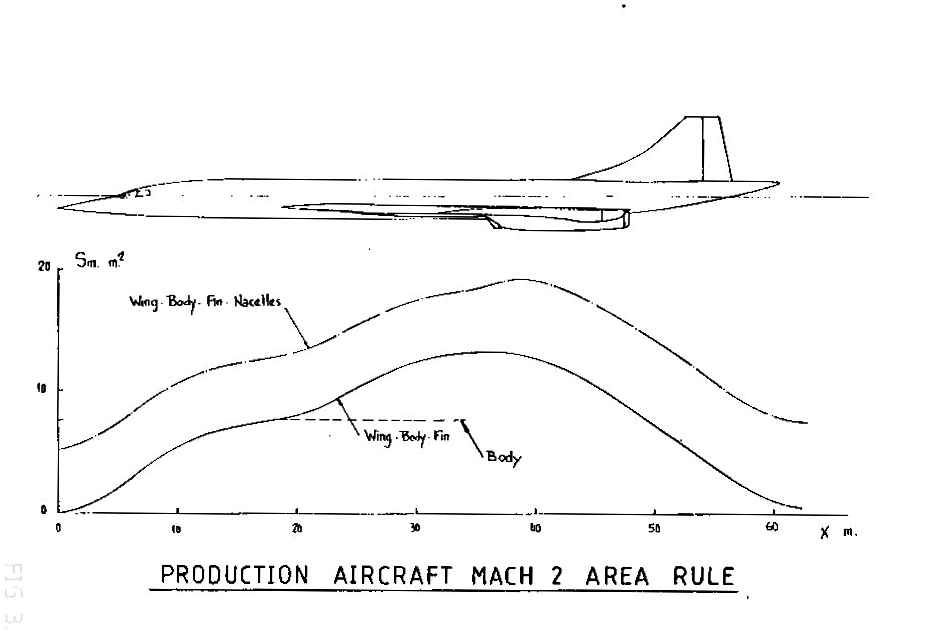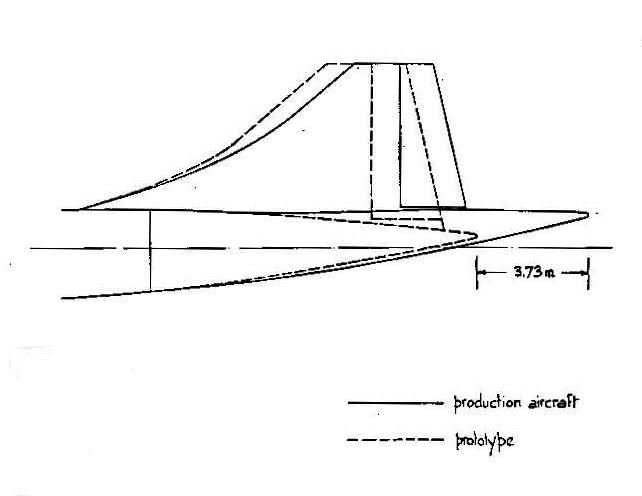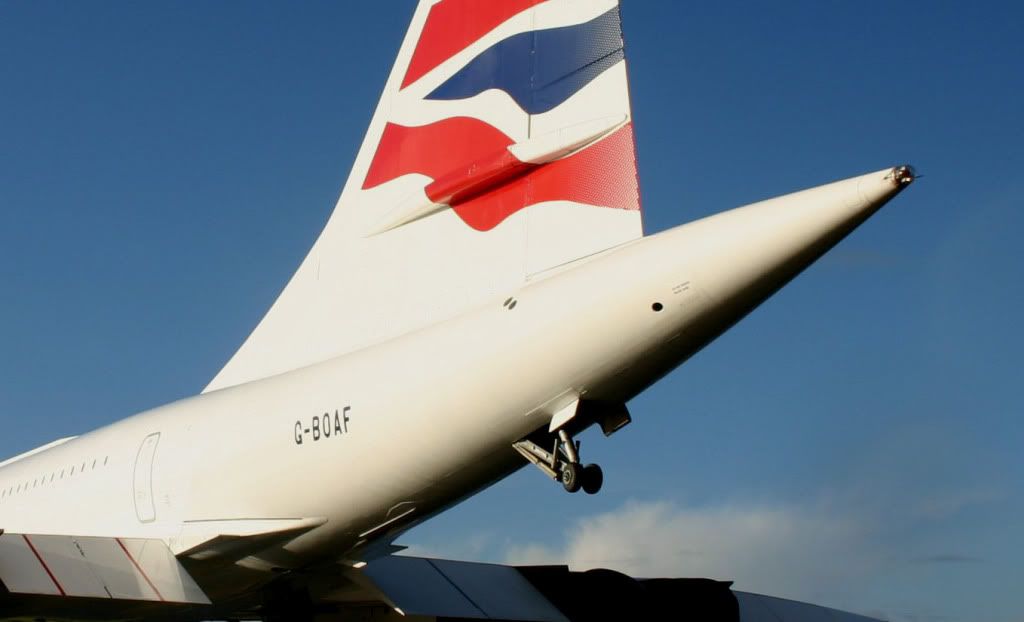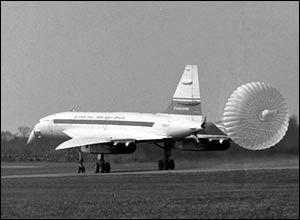January 18, 2011, 16:56:00 GMT
permalink Post: 6187329
 ).
).

Yes, the 188 was welded stainless and as you said, manufacturing was a pain. I didn't work on that aircraft myself, but one reported episode in the flight test programme is worth a digression off topic. Dialogue (maybe that should be monologue) between aircraft and FT control:
t = 0
Godfrey Auty (test pilot): "Mach ... port engine flamed out"
Silence from ground
t = 10secs
G.A.: "Mach .... starboard engine flamed out"
Silence from ground
t= 15 secs
G.A. "Well for Chrissake say something, even if it's only goodbye!"
Luckily the restart drills worked

After those AICU problems the boss came to see me (I was running the S&C section at the time) and said "Your blokes are doing dynamic simulation of aircraft response (on ANALOGUE computers!), do you think they could simulate the 188 intake control system?". To which of course there is only one answer possible, but that is how the two aerodynamicists who did most of the pioneering work on the Concorde AICU came to work together - Derek Morriss from the 188 project and Terry Brown from the S&C group. And boy were we lucky to have that combination

For the record, if my memory serves, the simulation showed that the 188 problem was hysteresis in the mechanical part of the 188 AICU.
Cheers
Clive
Subjects
AICU (Air Intake Control Computer)
Intakes
Links are to this post in the relevant subject page so that this post can be seen in context.
Reply to this quoting this original post. You need to be logged in. Not available on closed threads.
January 19, 2011, 08:27:00 GMT
permalink Post: 6188447
 Etienne would appreciate being called 'Wise' rather than Fage I'm sure!
Etienne would appreciate being called 'Wise' rather than Fage I'm sure!
Never before heard of that publication - how can I get to read copies?
Best regards
CliveL
Subjects
Intakes
Links are to this post in the relevant subject page so that this post can be seen in context.
Reply to this quoting this original post. You need to be logged in. Not available on closed threads.
January 30, 2011, 07:35:00 GMT
permalink Post: 6212066
As a result, there is a "twitch" on both the altimeter (barely visible) and on the VSI (verical speed indicator, very visible) when exceeding Mach 1.
CL
Subjects: None
No recorded likes for this post (could be before pprune supported 'likes').Reply to this quoting this original post. You need to be logged in. Not available on closed threads.
January 30, 2011, 19:07:00 GMT
permalink Post: 6213080

Dude - I DID say the pressure was peculiarly sensitive to angle, but I didn't remember those additional corrections. Amazing what memories this thread throws up

Subjects: None
No recorded likes for this post (could be before pprune supported 'likes').Reply to this quoting this original post. You need to be logged in. Not available on closed threads.
January 31, 2011, 13:50:00 GMT
permalink Post: 6214565

This one really shows it up Alpha Fox after last landing at Filton.
 ">
">
Cheers
CL
Last edited by CliveL; 1st February 2011 at 08:58 . Reason: addition of picture
Subjects
Filton
Links are to this post in the relevant subject page so that this post can be seen in context.
Reply to this quoting this original post. You need to be logged in. Not available on closed threads.
February 08, 2011, 16:01:00 GMT
permalink Post: 6231804
AZR - The MOD did ask us to look at a military application, but it didn't take long to show that it just wasn't on, and it soon got dropped
AJ - The print room below #4 DO - you have just explained a lot! Pain in the neck if you needed a drawing urgently
DM - The prototypes had brake parachutes and escape hatches, but I don't remember ever having to even think about spinning!
 ">
">
CSL
Last edited by CliveL; 8th February 2011 at 16:03 . Reason: add photo
Subjects: None
No recorded likes for this post (could be before pprune supported 'likes').Reply to this quoting this original post. You need to be logged in. Not available on closed threads.
March 31, 2011, 17:20:00 GMT
permalink Post: 6342275
which is sit left to the tank 8. Is there any specific reason for this?
Subjects: None
No recorded likes for this post (could be before pprune supported 'likes').Reply to this quoting this original post. You need to be logged in. Not available on closed threads.
April 05, 2011, 18:09:00 GMT
permalink Post: 6352281
Regards
CliveL
Subjects
Bleed Air
Links are to this post in the relevant subject page so that this post can be seen in context.
Reply to this quoting this original post. You need to be logged in. Not available on closed threads.
April 05, 2011, 19:54:00 GMT
permalink Post: 6352483

CliveL
Subjects: None
No recorded likes for this post (could be before pprune supported 'likes').Reply to this quoting this original post. You need to be logged in. Not available on closed threads.
April 06, 2011, 23:00:00 GMT
permalink Post: 6354939
Subjects
Expansion
Intakes
Links are to this post in the relevant subject page so that this post can be seen in context.
Reply to this quoting this original post. You need to be logged in. Not available on closed threads.
April 07, 2011, 11:16:00 GMT
permalink Post: 6355724
Subjects
Intakes
Shockwave
Links are to this post in the relevant subject page so that this post can be seen in context.
Reply to this quoting this original post. You need to be logged in. Not available on closed threads.
April 08, 2011, 08:06:00 GMT
permalink Post: 6357533
Last edited by CliveL; 8th April 2011 at 08:18 .
Subjects
Intakes
Vortex
Links are to this post in the relevant subject page so that this post can be seen in context.
Reply to this quoting this original post. You need to be logged in. Not available on closed threads.
April 08, 2011, 19:07:00 GMT
permalink Post: 6358637
Not so bad as it sounds in calendar years, as the annual utilisation of any one aircraft was very low, and there would also have been scope for life extension by applying certain modifications to the fuselage.
Subjects
Fatigue
Pressurisation
RAE Farnborough
Links are to this post in the relevant subject page so that this post can be seen in context.
Reply to this quoting this original post. You need to be logged in. Not available on closed threads.
April 10, 2011, 07:37:00 GMT
permalink Post: 6361040
Thanks for that info Dude - you were still working on the beast long after I left it!
Tomorrow is the launch for the 7th edition of Chris Orelbar's book and I hope to meet a few old friends there. Maybe something interesting will emerge

Subjects: None
No recorded likes for this post (could be before pprune supported 'likes').Reply to this quoting this original post. You need to be logged in. Not available on closed threads.
April 19, 2011, 06:28:00 GMT
permalink Post: 6399498
Also, I have asked the CAA surveyor who was most likely to have made that reskinning decision for more data. Perhaps he can remember the problem with the forward fuselage skins. Certainly when we were standing together inside 102 last week and talking about fuselage modifications for relifing the aircraft the problem of Component 30 was not mentioned!
I'll keep you in touch.
CliveL
PS: You were going to get a lot for your \xa330

Subjects: None
No recorded likes for this post (could be before pprune supported 'likes').Reply to this quoting this original post. You need to be logged in. Not available on closed threads.
April 20, 2011, 09:48:00 GMT
permalink Post: 6401886

CliveL
Subjects
Crown Modification
Links are to this post in the relevant subject page so that this post can be seen in context.
Reply to this quoting this original post. You need to be logged in. Not available on closed threads.
April 21, 2011, 17:44:00 GMT
permalink Post: 6404677
As the IAS decreased and AoA increased, the vortex started at the leading edge, and gradually grew in both size and contribution to overall lift until the vortex (or vortices) accounted for all the lifting force.
The vortices never provided all the lifting force. Up to about 6 or 7 deg AoA there was no vortex lift, just the usual wing tip vortices. Above that AoA the non-linear (vortex) lift grew steadily until at stall (about 23 deg AoA) the vortex lift was around 45% of the total.
Subjects
AoA
IAS (Indicated Air Speed)
Vortex
Links are to this post in the relevant subject page so that this post can be seen in context.
Reply to this quoting this original post. You need to be logged in. Not available on closed threads.
April 22, 2011, 07:19:00 GMT
permalink Post: 6405611
CliveL
Subjects
AoA
Vortex
Vortex AoA
Links are to this post in the relevant subject page so that this post can be seen in context.
Reply to this quoting this original post. You need to be logged in. Not available on closed threads.
April 22, 2011, 18:08:00 GMT
permalink Post: 6406576
Shaping the wing, and in particular the leading edge, optimised the effect on Concorde.
The Tu-144 design used the same information, which is a major reason for its resemblance to Concorde, rather than espionage...
How much the full advantages of the 'vortex lift' were understood at the time, is still an open question, IIRC.
I'll have to look for the original NASA TN (Tech Note)... it may be on the web somewhere.
But to be frank, the basic idea sprang from German research done during WW2. They were well ahead in knowledge of the aerodynamics of delta wings as part of their research into aircraft suitable for the higher speeds that went with those new-fangled jet engines. Then, after the war's end, the German scientists migrated to either the UK and US (if they were lucky) or got carried off to Russia. They brought with them all the knowledge they had gained (and of course there were specific trained teams whose job it was to search the German research establishment records for any useful data. On the UK side certainly the idea of exploiting vortex lift for use on an SST was generated by German researchers working at the RAE (Kuchemann and Weber in particular). My guess (I don't know for sure) is that similar things happened in the US, although "their Germans" seemed to be more interested in rocketry.
Clive
Subjects
HP-115
Tu-144
Vortex
Links are to this post in the relevant subject page so that this post can be seen in context.
Reply to this quoting this original post. You need to be logged in. Not available on closed threads.
April 22, 2011, 20:04:00 GMT
permalink Post: 6406673
I had thought I might have some pretty pictures but I haven't got anything for low AoA. I find it difficult to respond to such a general quetion though. Could you be a little more specific as to the bits that interest you?
I THINK the answer is no. You will get the bow shock of course and this will be reflected off the tunnel walls so you must have a big tunnel or a small model to avoid these reflected waves interfering with the flow over the tail of the model, but the pressure rise on the tunnel floor is 'static' and the tunnel walls are massive steel construction. I may be wrong here, but I associate sonic booms with a rapid rise in pressure and a 'movement' of that pressure rise past the observer. In a tunnel you don't get this 'dynamic' effect (unless of course you can arrange to walk past the working section at 660 mph

CliveL
Edited after some thinking
Last edited by CliveL; 22nd April 2011 at 22:15 .
Subjects
AoA
Sonic Boom
Links are to this post in the relevant subject page so that this post can be seen in context.
Reply to this quoting this original post. You need to be logged in. Not available on closed threads.